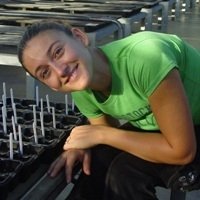
Wednesday, 15 January 2014
Not long after publishing a paper in a prestigious journal about plants being able to ‘talk' using sound, Monica Gagliano is back with her new findings showing that they can ‘learn'.
While this may sound stranger than fiction, Dr Gagliano, an Australian Research Council research fellow at The University of Western Australia's Centre for Evolutionary Biology, has solid evidence to support her theories, the latest of which is published in Oecologia.
Her work is becoming famous, with a recent mention by Michael Pollan in the New Yorker.
Her new article - written with Associate Professor Michael Renton and Dr Martial Depczynski from UWA's School of Plant Biology and Oceans Institute respectively, and Professor Stefano Mancuso at the University of Florence in Italy - is titled "Experience teaches plants to learn faster and forget slower in environments where it matters".
Dr Gagliano and her team show that Mimosa pudica plants can learn and remember just as well as it would be expected of animals, but of course, they do it all without a brain. Using the same experimental framework normally applied to test learnt behavioral responses and trade-offs in animals, they designed their experiments as if Mimosa was indeed an animal.
Dr Gagliano and her colleagues trained Mimosa plants' short- and long-term memories under both high and low-light environments by repeatedly dropping water on them using a custom-designed apparatus ( Mimosa folds its leaves in response to the drop). They show how Mimosa plants stopped closing their leaves when they learnt that the repeated disturbance had no real damaging consequence. Mimosa plants were able to acquire the learnt behaviour in a matter of seconds and as in animals, learning was faster in less favourable environment (i.e. low light). Most remarkably, these plants were able to remember what had been learned for several weeks, even after environmental conditions had changed.
Plants may lack brains and neural tissues but they do possess a sophisticated calcium-based signally network in their cells similar to animals' memory processes, they write.
The researchers concede that they do not yet understand the biological basis for this learning mechanism, nevertheless their set of experiments has major implications - not least, it radically changes the way we perceive plants and the boundaries between plants and animals, including our definition of learning (and hence memory) as a property special to organisms with a nervous system function of a nervous system.
Media references
Dr Monica Gagliano (UWA Centre for Evolutionary Biology, School of Animal Biology) (+61 8) 6488 1361
David Stacey (UWA Public Affairs) (+61 8) 6488 3229 / (+61 4) 32 637 716
Tags
- Channels
- International — Media Statements — Research — University News
- Groups
- Science Matters — UWA Institute of Agriculture